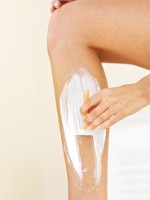|
|
|

Smooth Sailing for the Best Shave
How best to shave your legs and some alternatives
By Dr. Richard Thomas
Shaving is like brushing your teeth. It is generally a hassle, but it needs to be done, and the results are always satisfying. That is, unless you have a fight with your shaver every day. Here are some facts and tips to ensure your daily shave goes smoothly.
Shaving 101
Your legs must be wet for at least two to three minutes before applying your shaving cream. That way the hair is soft and pliable, easier to cut. Don't use soap, it just dries out your legs and makes for a poor shave.
Make sure you have the right tool. There are various styles of shavers, but not all legs or hair growth are the same. Triple blades work well, but no matter the blade type you use, change it frequently. If not done carefully, shaving can irritate the skin, the hair follicle, and the oil gland, which causes a rash. Ingrown hairs also pose a chance of infection. See a dermatologist for the right solution.
Choose a shaving cream or gel that contains emollients for a hydrating effect, and one that is fragrance free to avoid irritation to your skin. Steer away from products that contain irritants including alcohol, menthol and peppermint. Find yourself out of shaving cream? Hair conditioner or body cleanser works just fine.
Apply even pressure and shave against the growth of hair. Follow up with a moisturizer to keep your skin moist and supple. (Read about Moisturizers), but avoid creams with AHAs because the glycolic acid can irritate freshly-shaven skin.
Are there shaving alternatives?
Indeed there are. While temporary hair removal can be done by shaving, waxing or by epilation (electrolysis and thermolysis) another method is removing hair with a laser.
What is laser hair removal?
Light energy produced by a laser is targeted at the pigment in hair. This causes destruction of hair follicles while sparing surrounding structures (i.e., the skin).
Total temporary hair removal, which lasts for several months, can be done in almost all patients. However, total permanent laser hair removal is not commonly done. Stable permanent hair removal may be possible in some cases and usually requires multiple treatment sessions. You can read about Laser Hair Removal frequently asked questions
Who benefits from laser hair removal?
Almost anybody, however, this process works well for light-skinned, dark-haired individuals. There is no laser treatment yet that is effective for white, blond or red hair.
Be aware of some cautions if you go this route; such as dealing with existing bacterial or viral infections, psoriasis, or if you are on certain medications such as AccutaneŽ. See your dermatologist for more details if you are considering laser hair removal.
Laser hair removal facts
- The process can be mild to moderately uncomfortable.
- Most patients require three to six treatments. Long-lasting results depend on hair color, type of laser, and location treated.
- Complications are rare if performed by an experienced physician.
- Expect some pain, swelling and redness around the hair follicle after each treatment session.
- Check with your dermatologist about pre-operative care concerns.
Folliculitis alert
Shaving can also cause a condition called folliculitis, which is an inflammation or infection of hair follicles. It most often appears in areas that become irritated by shaving, the rubbing of clothes, or where follicles and pores are blocked by oil and dirt. Ask a dermatologist about solutions such as BactrobanŠ ointment to help heal these irritations. (Read more about bacterial infections)
What to watch for:
- a reddened rash
- raised, red, often pus-filled lesions around hair follicles (pimples)
- itching at the site of the rash and pimples.
How to prevent it:
- shave with an electric razor instead of a blade razor
- keep skin clean
- avoid clothing that rubs against the skin, damaging hair follicles.
About the author:
Richard Thomas, MD, FRCPC is Assistant Clinical Professor of Dermatology, Department of Dermatology and Skin Science, University of British Columbia, Vancouver, Canada.
|